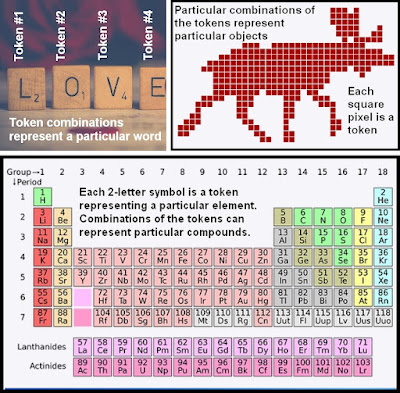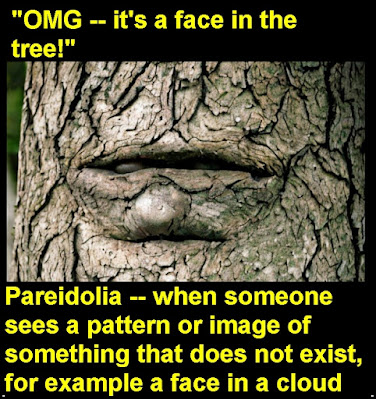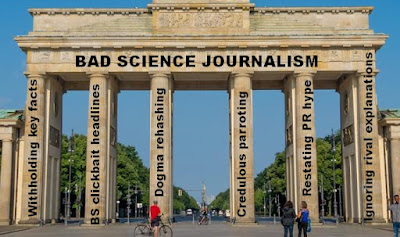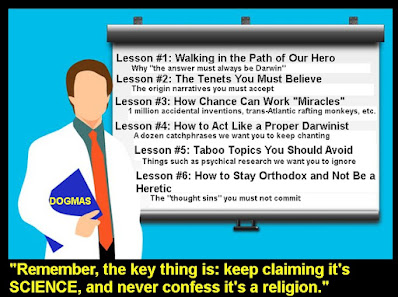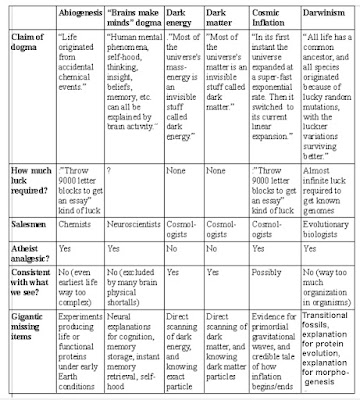Claims by neuroscientists that they have found "representations" in the brain (other than genetic representations) are examples of what very abundantly exists in biology: groundless achievement legends. There is no robust evidence for any such representations.
Excluding the genetic information stored in DNA and its genes, there are simply no physical signs of learned information stored in a brain in any kind of organized format that resembles some kind of system of representation. If learned information were stored in a brain, it would tend to have an easily detected hallmark: the hallmark of token repetition. There would be some system of tokens, each of which would represent something, perhaps a sound or a color pixel or a letter. There would be very many repetitions of different types of symbolic tokens. Some examples of tokens are given below. Other examples of tokens include nucleotide base pairs (which in particular combinations of 3 base pairs represent particular amino acids), and also coins and bills (some particular combination of coins and bills can represent some particular amount of wealth).
Other than the nucleotide base pair triple combinations that represent mere low-level chemical information such as amino acids, something found in neurons and many other types of cells outside of the brain, there is no sign at all of any repetition of symbolic tokens in the brain. Except for genetic information which is merely low-level chemical information, we can find none of the hallmarks of symbolic information (the repetition of symbolic tokens) inside the brain. No one has ever found anything that looks like traces or remnants of learned information by studying brain tissue. If you cut off some piece of brain tissue when someone dies, and place it under the most powerful electron microscope, you will never find any evidence that such tissue stored information learned during a lifetime, and you will never be able to figure out what a person learned from studying such tissue. This is one reason why scientists and law enforcement officials never bother to preserve the brains of dead people in hopes of learning something about what such people experienced during their lives, or what they thought or believed, or what deeds they committed.
But despite their complete failure to find any robust evidence of non-genetic representations in the brain, neuroscientists often make groundless boasts of having discovered representations. What is going on is pareidolia, people reporting seeing something that is not there, after wishfully analyzing large amounts of ambiguous and hazy data. It's like someone eagerly analyzing his toast every day for years, looking for something that looks like the face of Jesus, and eventually reporting he saw something that looked to him like the face of Jesus. It's also like someone walking in many different forests, eagerly looking for faces on trees, and occasionally reporting a success.
Claims that there are non-genetic representations in the brain often appeal to the existence of "place cells." Nature does not tell us that there is any such thing as "place cells." We merely know that there are cells, and that neuroscientists started to use the term "place cells" to try to spread ideas that cells help to represent some place where an organism has been in.
John O' Keefe published papers in the 1970's and after claiming to have detected "place units" in the hippocampus of rats. The papers also used the term "place cells." The claim was that certain cells were more active when a rat was in a certain spatial position. Greater activity during some type of observation is not representation. My eyes may widen if I see a naked woman walking down the street, but that is not a case of my eyes representing the naked woman. It has always been a case of misleading language when neuroscientists attempt to pass off claimed higher activation in some neurons as an example of representation. Real representation involves the use of symbolic tokens. Neuroscientists cannot find any symbolic tokens in the brain, other than the symbolic tokens in DNA that represent amino acids.
The "place cells" papers of John O'Keefe that I have examined are papers that do not meet standards of good experimental science. An example of such a paper was the paper "Hippocampal Place Units in the Freely Moving Rat: Why They Fire Where They Fire." For one thing, the study group size used (consisting of only four rats) was way too small for robust evidence to have been produced. 15 animals per study group is the minimum for a moderately convincing result in animal studies looking for correlations. For another thing no blinding protocol was used. And the study was not a pre-registered study, but was apparently one of those studies in which an analyst is free to fish for whatever effect he may feel like finding after data has been collected, using any of innumerable possible analysis pipelines.
The visuals in the "place cell" studies done by O' Keefe compared wavy EEG signal lines collected while a rat was in different areas of an enclosed unit. You can see what I'm talking about by looking at page 1334 of the document here. The wavy signal lines look pretty much the same no matter which area the rats were in. But O'Keefe claims to have found differences. No one should be persuaded that papers using analysis so subjective show robust evidence for an important real effect. We should suspect that the analyst has looked for stretches of wavy lines that looked different when the rat was in different areas, and chosen stretches of wavy lines that best-supported his claim that some cells were more active when the rats were in different areas.
When I looked for later "place cell" papers by O'Keefe, I saw papers that seemed to just continue the same Questionable Research Practices. Specifically:
- A 1993 paper co-authored by O'Keefe was entitled "Phase Relationship Between Hippocampal Place Units and the EEG Theta Rhythm." The paper used way-too-small study group sizes of only three rats and two rats. No blinding protocol was used, and the paper was not a pre-registered study. We have some wavy-line analysis that seems extremely subjective and arbitrary.
- A 2008 paper co-authored by O'Keefe was entitled "The boundary vector cell model of place cell firing and spatial memory." The paper used a way-too-small study group size of only two rats. For example, we read "Twenty five place cells were recorded from the two rats." No blinding protocol was used, and the paper was not a pre-registered study. We should chuckle when the paper says that "we followed 11 cells for time courses varying from a day to the duration of the experiment" and confesses ungrammatically that " it is difficult to draw firm conclusions from such as small data set." There are millions of cells in the brain of a rat. Paying attention to only a handful of such cells seems like ridiculous cherry picking.
- A 2012 paper co-authored by O'Keefe was entitled "How vision and movement combine in the hippocampal place code." The paper used a way-too-small study group sizes of only six mice. No blinding protocol was used, and the paper was not a pre-registered study. We have some data analysis that seems extremely subjective and arbitrary.
- A 2014 paper co-authored by O'Keefe was entitled "Long-term plasticity in hippocampal place-cell representation of environmental geometry." The paper used a way-too-small study group sizes of only three animals. No blinding protocol was used, and the paper was not a pre-registered study.
Studies like this are generally not good evidence unless a very stringent blinding protocol is used, and studies like this almost invariably fail to follow any kind of blinding protocol. It's easy to find the failure: just search for the word "blind" or "blinding" in the text of the paper, and note well when it fails to occur.
In general, there is nothing scientific about using nicknames such as "place cells" to describe cells. The justification given for the use of such a term is based not on observations of permanent features of any cells, but on subjective judgments of how the cells behaved at particular moments. That's as unscientific and subjective as saying that certain people have "fear eyes" or "sorrow eyes," based on subjective judgments of how their eyes looked at particular moments.
Although O'Keefe's "place cell" papers were not at all a robust demonstration of any important effect, the myth that "place cells" had been discovered started to spread around among neuroscience professors, aided by the use of a catchy memorable catchphrase: "place cells." O'Keefe even got a Nobel Prize in 2014. The Nobel Prize committee is normally pretty good about awarding prizes only when an important discovery has been made for which there was very good evidence. Awarding O'Keefe a Nobel Prize for his unconvincing work on supposed "place cells" was a very bad flub of the normally trusty Nobel Prize committee. Even if certain cells are more active when rats are in certain positions (something we would always expect to observe from chance variations), that does nothing to show that there is anything like a map of spatial locations in the brain of rats or mice.
The Nobel Prize committee's flub in awarding a Nobel Prize to O'Keefe was not the only case of a Nobel Prize awarded for very weak experimental evidence. The same thing occurred when a Nobel Prize was awarded to Christian B. Anfinsen, who failed to ever produce robust experiments backing up his claim known as Anfinsen's Dogma. As discussed in my post here, subsequent research has failed to confirm Anfinsen's Dogma, and has given reason for doubting that Anfinsen ever deserved to get a Nobel Prize. We must remember that when scientists really, really want to believe something, they may tend to award some prize for experimental or observational activity that claimed to back up the cherished belief. The awarding of the Nobel Prize to O'Keefe was part of the social construction of the groundless triumphal legend that neuroscientists had found non-genetic representations in the brain, a legend that neuroscientists fervently wanted to believe.
What I think goes on during such failures of the Nobel Prize committee is that the committee members make the great mistake of judging based on quantity of papers rather than the quality of the experimental methods and observations. The committee members may think something like, "There are now many papers published about Effect X, so I guess the first people reporting Effect X must have made a discovery." No, that's not necessarily so, because there can occur bandwagon effects within scientist belief communities, in which dubious fashionable ideas are embraced in a kind of groupthink herd effect. So, for example:
- Endless papers were produced on the topic of supersymmetry theory, which was never well-established.
- Endless papers were produced on the topic of string theory, which was never well-established.
- Endless papers were produced on the topic of Grand Unification Theories, which were never well-established.
- Endless papers were produced on the topic of cosmic inflation theory, which was never well-established.
- Many papers were produced claiming to provide evidence for memory engrams, none of them providing convincing evidence for such a thing.
- Many papers were produced claiming to provide evidence for morphogen gradients transmitting positional information, none of them providing convincing evidence for such a thing.
What would a convincing experiment showing representations in a brain look like? It might work like this. You might have some "blinded" analysts who had no idea of what claims were being made about representations, and no idea of what the goals, procedures or suspicions of the neuroscientists were. Such analysts might be shown some data such as EEG data or brain scan data, and the analysts might be told, "We think that in this data may be representations of something an organism observed or experienced -- can you guess what that was?" If most of the analysts gave the same answer (such as describing the layout of a particular type of maze that a rat ran through), that might be good evidence that neural representations had been found; for there would be very many thousands of possible answers, so we would not expect most of the answers to coincidentally agree. Nothing like that has occurred in any of these experiments claiming evidence for brain representations. Instead, we typically have some procedure vastly less convincing, in which a scientist who knows that some rodents observed some particular thing attempts to sift through lots of data, looking for something that he can claim is evidence for a representation of that thing, rather like some person walking through a forest of 1000 trees, eagerly looking for some tree that has a face shape on it.
There is no robust evidence for any spatial representations in the brain. "Place cells" are a social construct of neuroscientists, not something with an objective reality in nature. What would we expect to find if such claims of representations in the brain are not well-founded? One thing we might expect to find is that there would be great inconsistency in the descriptions of such claimed representations, with little replication of the same results. That is just what seems to have happened. Neuroscientists have invented an inaccurate phrase to describe such inconsistencies. The phrase they are now using is "representational drift." The phrase is an inaccurate one, because there are no actual representations that are drifting. It is simply claims of such representations that are varying.
A scientific paper makes claims about such claimed "representational drift." The paper makes an unjustified use of the term "PPC representation" referring to some alleged representation in the posterior parietal cortex, a representation that has not actually been shown to exist
"Crucially, Driscoll and colleagues found that the PPC representation was not stable over multiple days and weeks. As shown in each row of Figure 1b, the same neurons exhibited markedly different activation patterns on different days....Similar types of drift have been reported in a number of brain areas, including the hippocampus and sensory and motor parts of neocortex. In addition, there is widespread evidence for surprising degrees of structural plasticity in dendritic spines. For example, in the hippocampus, all dendritic spines are expected to turn over in the period of several weeks. Such dramatic synapse turnover suggests that circuits are continually rewiring even though animals can maintain stable task performance and memories...The finding of representational drift raises profound questions about how behavior is learned and controlled in neural circuits, and what constitutes a memory of such learned behavior."
Another paper on so-called "representational drift" states this:
"Cells whose activity was previously correlated with environmental and behavioral variables are most frequently no longer active in response to the same variables weeks later. At the same time, a mostly new pool of neurons develops activity patterns correlated with these variables. Less commonly, cells previously correlated with certain variables become correlated with new variables. In one example of these findings, as mice move through an environment, a subpopulation of hippocampal place cells are informative about the animal's spatial position. Over time, the pool of place cells that make up this spatial code changes, despite the environment staying the same."
There is a simple and plausible explanation for such results:
(1) Brains do not actually contain representations of anything learned by humans or animals, and no neuroscientist has ever produced a credible theory of how learned information could be stored as brain states or neural states.
(2) Experimental claims that the brain contains such representation were never robust science, but involved experiments guilty of Questionable Research Practices such as way-too-small study group sizes, a lack of a blinding protocol, a lack of pre-registration, and subjective "see whatever you want to see" cherry-picking analysis.
(3) The reported "representational drift" is the kind of random variation and vanishing of reported correlations we would expect given a scientific result that was never robust, but was always based on dubious subjective analysis of randomly varying ambiguous data. and mere pareidolia (people seeing patterns in random data that they were hoping to see).
Neuroscientists are using extremely misleading language when they claim to see something they call "superior activations" or "higher activations" or "activation patterns" and then pass off such claimed observations as evidence for representations. The concept of a "cell activation" is not even a solid one, and the term "higher cell activation" or "activation pattern" has no precise meaning. Letting us know exactly when they are active, light switches have an "on" position and an "off" position, but cells have no such things. Representations involve symbols in which one thing stands for another. If there were to exist some mere "higher activation" of a cell, that would not be a representation. If I see a naked woman on the street, there may be some higher activation of my eyes, with my eyes widening. Such a thing is not a representation of a naked woman.
When the genetic code was discovered in DNA, that was not some thing merely involving "higher cellular activations." That was a discovery of a massive storehouse of symbolic tokens in DNA -- particular combinations of nucleotide base pairs which represented particular amino acids. Other than such a genetic code, there simply is no evidence of representations in the brain. There is zero robust evidence that brains store representations of any learned knowledge or any place where an organism has visited. Trying to use some catchphrase of "place cells" to pass off claims of higher cell activations as evidence of neural representations is an example of professorial pareidolia.
Claims that are "place cells" in the hippocampus that represent places are discredited by experiments involving tests of navigation memory in monkeys who had been given severe lesions of the hippocampus. The paper "Object Recognition and Location Memory in Monkeys with Excitotoxic Lesions of the Amygdala and Hippocampus" did tests on 11 monkeys who were given severe hippocampus lesions and also lesions of the amygdala. According to Table 1, seven of the monkeys had an average of 73% of the left and right hippocampus damaged. We read this:
"Postoperatively, monkeys with the combined amygdala and hippocampal lesions performed as well as intact controls at every stage of testing. The same monkeys also were unimpaired relative to controls on an analogous test of spatial memory, delayed nonmatching-to location. It is unlikely that unintended sparing of target structures can account for the lack of impairment; there was a significant positive correlation between the percentage of damage to the hippocampus and scores on portions of the recognition performance test, suggesting that, paradoxically, the greater the hippocampal damage, the better the recognition."
